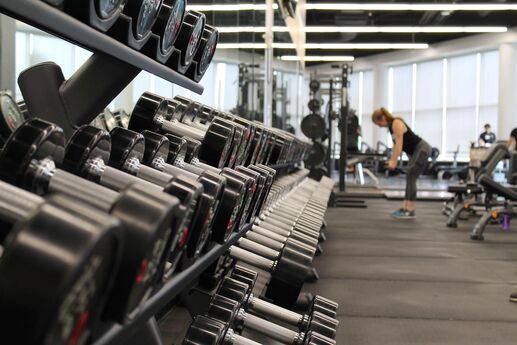Here’s the only article you need to read to be fit and healthy in the new year -- and beyond.
News flash: We regret to inform you that any unrequested email offering ways to lose pounds and gain muscle as you sleep -- for only $19.99! -- is a scam (which rhymes with “spam.” Coincidence? Not!).
Fortunately, making good on that new year’s resolution to tone your body and prime your health doesn’t have to involve an expensive gym membership and a crazy amount of free time. Simply modify a few habits and add some simple exercises -- even if they’re at your desk -- into your busy day, and you’ll notice a major difference.
These 25 realistic fitness and health tips, put together by a pair of nationally respected physical trainers, are aimed at busy people on a budget. Consider it your own personal health care reform for 2010.
Preparation:
1. Look in the mirror. Assess your fitness and health goals. Decide how much you want to exercise, and commit. Exercise is more easily managed when it’s divided into smaller chunks throughout the day, says Pete McCall, an exercise physiologist with the American Council on Exercise.
Morning:
2. Get up and get moving. “Do yoga for five or 10 minutes. Or walk your dog for two quick laps around your building or block,” says Gregory Florez, CEO of Fit Advisor health coaching services. “This wakes you up much like the way caffeine does -- and you won’t have the drop in energy later. It also gets blood flowing.”
3. Don’t give up. Studies have shown that you need to repeat a routine (like morning exercising) for three weeks before it becomes a habit. “Most people start a routine and fall off. Give it those three weeks,” says Florez.
4. Start modestly. If you commit to running 5 miles a day five days a week, you’re bound to quit. Begin with, say, 15 minutes on the stair-climber, two or three days a week. “Once you start achieving smaller goals, it’s easier to work your way to bigger goals. Committing to do something a couple times a week is attainable,” says McCall.
5. Eat breakfast daily (as per mom). Breakfast flips on your metabolism like a furnace switch, so your body fires up and starts burning calories. McCall recommends a carbohydrates-protein combo. On Sunday nights, he premixes yogurt, granola and berries, and stores them in a container for five days’ worth of quick breakfasts.
At the Office:
6. Stretch. Especially if you’re tired, stretching will help you stay awake and limber. McCall recommends simply standing up, reaching your left hand above your right shoulder and slowly twisting your torso left as far as you can, then right. Repeat with right hand, left shoulder.
7. Breathe. Make an appointment every hour to stand up at your desk and take a few deep breaths. “You’ve got to schedule it with the same rigor you schedule any business meeting,” says Florez. “It’s important to re-oxygenate your body.”
8. Pack snacks. “I bring fruit and nuts and seeds with me, and keep them in my desk all week. Foods from fresh, whole sources have a lower glycemic index than sugary foods so you don’t get that high energy spike, then a big crash,” says McCall.
9. Go the distance. Use the bathroom farthest from your desk to get in some extra walking.
10. Drink water all day. Before lunch, down 12 ounces. “We often feel hungry when we’re just dehydrated,” says Florez. “Be that nerdy guy with the reusable water bottle at the desk.”
11. Walk it off. After lunch, take a few laps around the building.
12. Walk and talk. Got a Bluetooth headset? Then head outside and make a phone call while taking a stroll. “You’re cheating your body into really small chunks of exercise throughout the day when you otherwise won’t make the time,” says Florez.
13. Accessorize with exercise. Stash a set of rubber exercise tubes at your office so you can do chest presses, rows or squats right at your desk -- two or three times a day. “That way you get your strength training in, in an accumulated way, throughout the day,” says Florez.
Evening:
14. Get these: A medicine ball, balance ball and the TRX Suspension System (Fitness Anywhere Web site). With them, says McCall, your aerobic and strength options are almost limitless. (Many books and Web sites offer workout instructions for medicine balls and balance balls, and a personal trainer can also create a personal plan for you. The TRX system comes with its own instructional DVD.)
15. Befriend the TV. Either take advantage of the on-demand workout videos offered by many cable providers or get a workout DVD for living room workouts, urges Florez.
16. Don’t just sit there. If you’re watching TV, get off the couch during commercials. “Knock out two to three exercises at each break. By the end of the hour, you’ve hit every muscle group,” says Florez.
17. Do the balance ball pike exercise. First, in case you’re wondering, a “pike” is an exercise that works the abs and shoulders. Now on to this one: Facing the floor, rest your thighs on the ball and put the palms of your hands on the ground, arms extended (like you’re at the top of a push-up). Raise your rear in the air, allowing the ball to roll toward your feet, and keep your legs straight, says McCall. Do three sets of five. Feel the burn.
18. Do the medicine ball wood chop. Squat down, legs spread shoulder-width apart. Hold the ball between your knees; as you stand up, grasp the ball with your hands, swinging it overhead, says McCall. Do one to three sets of 15.
19. Exercise intervals. Intervals are essential for strength work or a cardio workout. “Go hard for an exercise for two to three minutes, dial back, then up the exertion again,” says Florez. Do this two or three times a week. It not only breaks up the monotony of always exercising at the same pace but also benefits your cardiovascular system.
Sleep
20. Set a consistent sleep schedule. Your body will thank you for it, and you’ll have more energy to exercise. Yes, eight hours a night is important, and no, you can’t make up for lost sleep during the weekends, says McCall.
21. Close the fridge by 8 p.m. “Don’t go to bed on a full stomach. It’ll interrupt your sleep cycle,” says Florez.
22. Wind down. “[Stretching before bed] becomes a signal to your body that it’s time to wind down,” says Florez. (He recommends enlisting a personal trainer to create a stretching routine.)
23. Get the TV out of your bedroom. Too much visual stimulation will make for lousy sleep.
24. Set bedroom boundaries. Don’t bring work into your chambers. “Your bedroom should only be for sleeping, having sex or relaxing,” says Florez.
25. Create a nightly routine. That’s how your parents used to get you to
sleep. “Sometimes it’s a really hot shower. Sometimes it’s reading fiction -- something
that will calm the body down,” says Florez.






